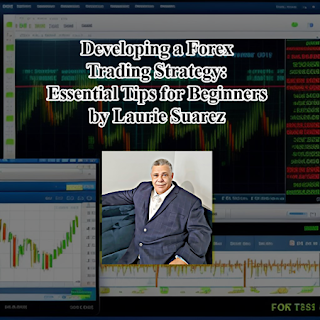Developing a Forex Trading Strategy
Essential Tips for Beginners by Laurie Suarez (www.lauriesuarez.blog)
Introduction
Developing a solid
forex trading strategy is crucial for beginners looking to navigate the dynamic
currency markets effectively. A well-defined strategy provides a framework for
making informed trading decisions and managing risk. In this blog, we will
explore essential tips to help beginners develop a forex trading strategy that
aligns with their goals and trading style.
- Define Your
Trading Goals and Risk Tolerance
Before developing a
trading strategy, it's important to define your trading goals and risk
tolerance. Determine whether you aim for short-term gains or long-term growth.
Assess your comfort level with risk and volatility to establish appropriate
risk management measures within your strategy.
- Choose a Trading
Style
There are various
trading styles in forex, including scalping, day trading, swing trading, and
position trading. Each style requires a different approach and timeframe for
holding positions. Choose a trading style that suits your personality, time
availability, and risk tolerance.
- Understand Market
Analysis
Successful trading
strategies rely on effective market analysis. Learn the basics of technical
analysis, which involves studying price charts, patterns, and indicators.
Familiarize yourself with fundamental analysis, which focuses on economic
indicators, news events, and geopolitical factors. Combining both approaches
can provide a comprehensive understanding of the market.
- Set Clear Entry
and Exit Rules
Establish clear entry
and exit rules based on your analysis. Determine the criteria that signal a favourable
entry point and the conditions that suggest it's time to exit a trade. This
helps remove emotions from your decision-making process and ensures consistency
in executing your trades.
- Implement Risk
Management Techniques
Risk management is
vital for preserving your trading capital. Define the maximum amount you are
willing to risk per trade as a percentage of your account balance. Utilize
stop-loss orders to limit potential losses, and consider incorporating trailing
stops to protect profits as a trade moves in your favour.
- Backtest and Demo
Trade
Before deploying your
strategy in live trading, backtest it using historical data. This allows you to
evaluate its performance under different market conditions. Additionally, demo
trade using virtual funds to practice executing trades and gain confidence in
your strategy.
- Keep a Trading
Journal
Maintain a trading
journal to record your trades, including entry and exit points, reasons for
taking the trade, and the outcome. Regularly review your journal to identify
strengths, weaknesses, and areas for improvement in your strategy. This
self-reflection can help refine your approach over time.
- Continuously
Learn and Adapt
Forex markets are
dynamic, and staying ahead requires continuous learning. Stay updated with
market news, economic releases, and industry developments. Attend webinars,
read educational resources, and follow experienced traders to expand your
knowledge and adapt your strategy as needed.
Conclusion
Developing a forex
trading strategy is a crucial step for beginners entering the forex market. By
defining your goals, choosing a trading style, understanding market analysis,
setting clear entry and exit rules, implementing risk management techniques,
backtesting, demo trading, maintaining a trading journal, and continuously
learning, you can build a strong foundation for your trading journey. Remember,
developing a successful strategy takes time, practice, and a commitment to
ongoing improvement.
 |
| Developing a Forex Trading Strategy: Essential Tips for Beginners by Laurie Suarez |


Comments
Post a Comment